ABIT AT7 (VIA KT333) Mainboard
|
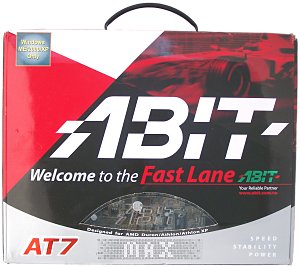
This board is of the new MAX series - it has a great deal of differences
from its competitors and even other Abit series. The general conception
of this model line is that the boards are turned to the Future without
even a hint of looking back. The board is redesigned completely - PS/2
ports are deleted, there are only 3 PCI slots, a lot of USBs, Firewire
ports and a great many integrated components. Besides, the BIOS offers
a great deal of settings!..
Accessories:
- Package of a standard design with a handle; the board is put into a plastic
bag;
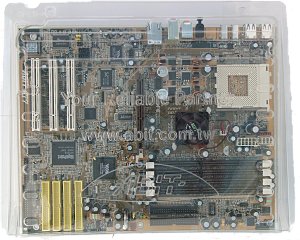
- Documentation: a user manual and a brief BIOS adjustment (for better performance)
- in English;
- Cables: 3(!) ATA66/100/133 and 1 FDD;
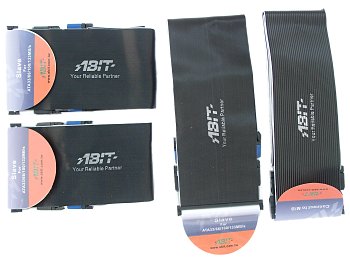
- Bracket with 2 USB 1.1 ports;
- Bracket for the rear computer panel;
- Several clips for cables;
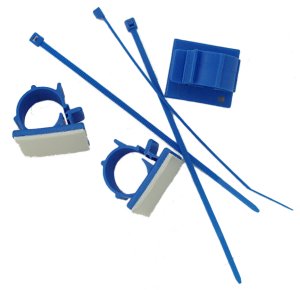
- Diskette with drivers for IDE RAID;
- CD with software:
- drivers;
- user manual in PDF;
- 3Deep E-Color;
- Norton Antivirus 2002;
- Adobe Acrobat Reader;
- Buzzsoft programs;
- InterVideo WinDVD;
- system monitoring utility;
- DirectX 8.1.
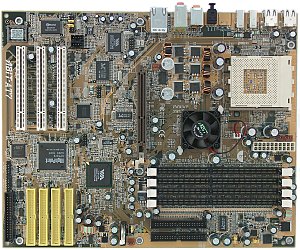
There are no flaws in the layout: it is the first time an ATX board
has only three PCI slots. It's not difficult to reach switches and jumpers
even when the board is already installed. Their functions are shown on
the textolite.
The 3-channel switching voltage regulator incorporates 9 capacitors
of 4700 uF and 5 of 2200 uF.
The following controllers are integrated:
- audio controller based on the Avance Logic ALC650 AC'97 codec with a connector
for front audio-outs and support of acoustic systems 5.1;
- network controller based on the Realtek RTL8100B chip supporting 10 BaseT/100
BaseTX;
- IDE RAID controller based on the HighPoint HPT374 chip able to connect
up to 8 devices via the ATA133 protocol and create RAID 0, 1 and 0+1;
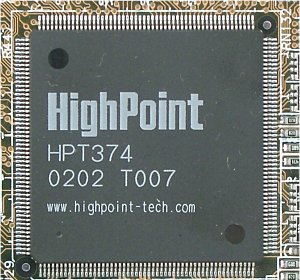
- USB 2.0 bus controller based on the VIA VT6202 chip;
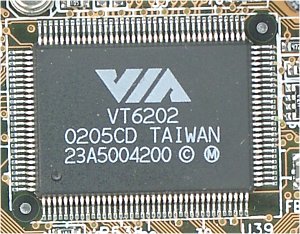
- IEEE1394 bus controller based on the Texas Instruments TSB43AB23.

Non-unsoldered connectors: SPDIF-In connector (TosLink).
The system monitoring is supported by the Winbond W83697HF chip. What
is controlled:
- voltage of processor, +3.3, +5 and +12 V, AGP and memory buses, VBAT and
+5 V Standby;
- speed of 2 fans;
- temperatures of the processor (thermodiod in processor socket) and the board (a built-in
sensor).
There are 2 connectors for adjustable connection of fans and 3 for non-adjustable
connection (one is connected to a fan on a heatsink of the chipset's north
bridge).
Brief characteristics of the board: memory slots - 4 DDR SDRAM;
expansion slots - AGP/ 3 PCI; I/O ports - 6 USB 1.1/ 4 USB 2.0/ 2 IEEE
1394a; dimensions - 305x245 mm.
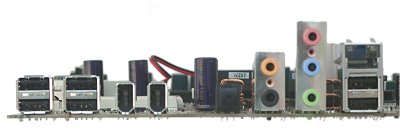
Adjustment can be carried out with:
| jumpers and switches |
Jumper to clear up the CMOS |
 |
| BIOS based on the ver.6.00PG from Phoenix-Award |
Setup of memory timings |
+ |
CAS Latency, Bank Interleave, Precharge to Active, Active to
Precharge, Active to CMD, DDR DQS Input Delay, DDR DQS Output Delay, MD Drive
Strength, CMD Drive Strength, Enhance DRAM Performance, DRAM Access, Queue Depth,
Command Rate, Feedback Delay |
| Setup of memory frequency |
+ |
100, 133 and 166 MHz |
| Setup of AGP bus |
+ |
 |
| Setup of PCI bus |
+ |
 |
| Changeable scaler of AGP and PCI buses |
+ |
FSB:AGP:PCI = 3:2:1, 4:2:1 and 5:2:1 |
| Manual assignment of interrupts |
+ |
 |
| Changeable FSB frequency |
+ |
100-250 MHz in 1 MHz steps |
| Changeable CPU multiplier |
+ |
x5-x13 |
| Changeable core voltage |
+ |
1.1-1.85 V in 0.025V steps |
| Changeable memory voltage |
+ |
2.55, 2.65, 2.75 and 2.85V |
| Changeable chipset voltage |
+ |
3.5 and 3.65 V |
| Changeable AGP bus voltage |
- |
 |
We used the latest available version of the BIOS - 8R.
It must be noted that although we adjusted the BIOS settings according
to the recommendations of the manufacturer, the board didn't show any extraordinary
efficiency at the rated frequencies. At the same time, it has a lot of
overclocking features, that is why this model is a choice of users who
are fond of new stuff, often squeeze the last drop out of their hardware,
use all progressive things and are not faithful to old formats and components.
The board may seem to be too ahead its time, and even advanced users won't
be able to use all its capabilities.
Test results:
Write a comment below. No registration needed!
|
|
 |
|
|
|









